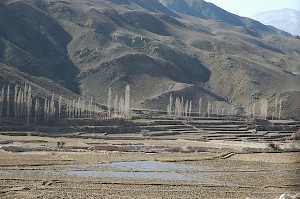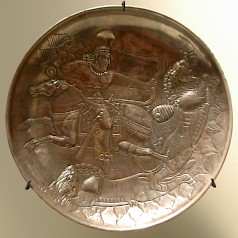Hyrcania
Q48726Hyrcana (Old Persian Varkâna, "country of wolves"; Akkadian Urqananu): part of the ancient Achaemenid empire, on the southern shores of the Caspian Sea, now called Gorgan.

Hyrcania is situated between the Caspian Sea - which was called Hyrcanian Ocean in Antiquity - in the north and the Elburz mountains in the south and west. The country has a tropical climate and is very fertile; the Persians considered it one of "the good lands and countries" which their supreme god Ahuramazda had created personally (text). To the northeast, Hyrcania is open to the Central-Asian steppe, where nomads have been living for centuries; on several occasions, they invaded the country.
Hyrcania became part of the Achaemenid Empire during the reign of king Cyrus the Great (r.559-530) or Cambyses (r.530-522). The satrap's capital was called Zadracarta, and was possibly identical to modern Sari. There is no report about the conquest of Hyrcania, but from the Behistun inscription we know that it was Persian by 522. The story is as follows:
After the death of Cambyses, the Magian usurper Gaumâta, who did not belong to the Achaemenid dynasty, usurped the throne. The adherents of the Persian royal house, however, helped Darius to become king; he killed the usurper on 29 September 522. Almost immediately, the subjects of the empire revolted. When Darius was suppressing these rebellions and stayed in Babylon, the Median leader Phraortes made his bid for power (December 522). His revolt soon spread to Armenia, Assyria, Parthia and Hyrcania.

However, the Persian garrison in Parthia still held out. It was commanded by Darius' father Hystaspes. On 8 March 521, the Parthians and their allies, the Hyrcanians, attacked the Persian garrison, but they were defeated. Not much later, Darius was able to relieve his father. This was the first appearance in history of the Hyrcanians.In the fifth century, the Greek researcher Herodotus of Halicarnassus mentions them several times in his Histories. He has a confused report on irrigation,note which may be compared to the statement of the second-century historian Polybius of Megalopolis that the Persians had built large irrigation works.note Herodotus also tells us that Hyrcanian soldiers were part of the large army which king Xerxes (r.486-465) commanded against the Greeks in 480 BCE. The historian notes that they carried the same arms as the Persians.note Perhaps, they stayed in Lydia after the war; we know of a Hyrcanian garrison guarding the valleys of the Caicus and Hermus.

In the confused years after the death of king Artaxerxes I Makrocheir (r.465-424), three of his sons succeeded to the throne: Xerxes II, Sogdianus and Darius II. The latter was satrap in Hyrcania and may have used troops from Hyrcania and the "upper satrapies", that is Aria, Parthia, Arachosia, Bactria and Sogdia.
Hyrcania makes its reappearance in history when the Macedonian king Alexander the Great (r.336-323) invaded Asia. Hyrcanians are mentioned during the battle of Gaugamela (1 October 331), and in August 329, when the last Persian king, Darius III Codomannus, was dead, many Persian noblemen fled to Hyrcania, where they surrendered to Alexander (a.o. Artabazus).
After Alexander's reign, his kingdom fell apart and Hyrcania became part of the new empire of the Seleucid rulers, a Macedonian-Greek dynasty. At the end of the third century BCE, northeastern nomads belonging to the tribe of the Parni, invaded Parthia and Hyrcania. Although Parthia was forever lost to the Seleucids, Hyrcania was in the last decad of the third century reconquered by king Antiochus III the Great (r.222-187). After a generation, however, Hyrcania was lost again.

To the Parthians - the new name of the Parni - Hyrcania was an important part of the empire, situated between their Parthian territories and their homeland on the steppe. It is certain that the Parthian kings used a Hyrcanian town as their summer residence. Nonetheless, it was not an uncontested part of their empire; for example, it is known to have revolted in 58 CE.
It is possible - and seems increasingly likely - that during the Sasanian period, a wall was built to defend Hyrcania against the nomads of the Central-Asian steppe. The ruins of the wall north of the river Gorgan that are visible today and are called "Wall of Alexander", although they are in fact younger.